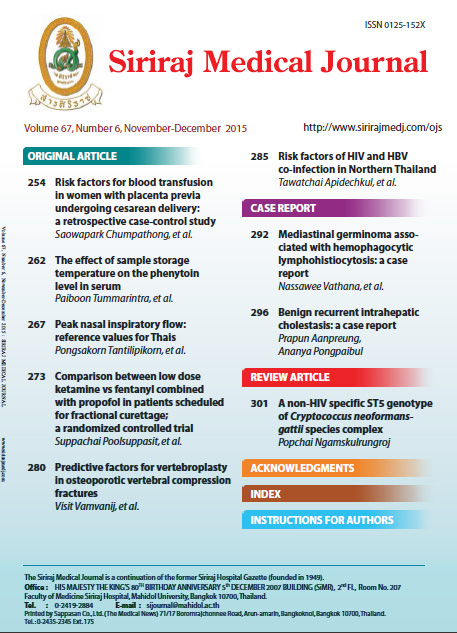Peak Nasal Inspiratory Flow: Reference Values for Thais
Abstract
Objective: Nasal obstruction can be measured objectively by rhinomanometry and acoustic rhinometry, both complex techniques. Peak nasal inspiratory flow (PNIF) is also a tool for evaluating nasal obstruction. This study aimed to establish normal PNIF ranges for an Asian population accounting for sex, age, weight, and height.
Methods: Using a portable Youlten peak flowmeter, PNIF was measured in 180 healthy Thais (ages 15-70 years). Normal ranges for male and female subjects, adjusted for weight and height, were determined using multiple regression analysis.
Results: Body mass index values (mean ± S.D.) of the 82 male and 98 female subjects were 24.9 ± 4.5 and 21.7 ± 4.3 kg/m2, respectively. PNIF was significantly higher in males than in females (139 ± 37.6 vs. 97.1 ± 27.1 l/min, p<0.001). After adjusting for weight and height, PNIF reference ranges (lower and upper limits with 95% confidence intervals, respectively) were 126.8 (124.5 to 129.1) and 151.2 (148.9 to 153.5) l/min for males and 82.5 (80.0 to 85.0) and 111.7 (109.2 to 114.3) l/min for females.
Conclusion: Sex, height, and weight affected the PNIF rate. This study has provided normal PNIF ranges for healthy male and female Thai population that account for weight and height.
Keywords: Peak nasal inspiratory flow, nasal airflow, nasal obstruction, normal value, reference range
Downloads
Published
How to Cite
Issue
Section
License
Authors who publish with this journal agree to the following conditions:
Copyright Transfer
In submitting a manuscript, the authors acknowledge that the work will become the copyrighted property of Siriraj Medical Journal upon publication.
License
Articles are licensed under a Creative Commons Attribution-NonCommercial-NoDerivatives 4.0 International License (CC BY-NC-ND 4.0). This license allows for the sharing of the work for non-commercial purposes with proper attribution to the authors and the journal. However, it does not permit modifications or the creation of derivative works.
Sharing and Access
Authors are encouraged to share their article on their personal or institutional websites and through other non-commercial platforms. Doing so can increase readership and citations.










